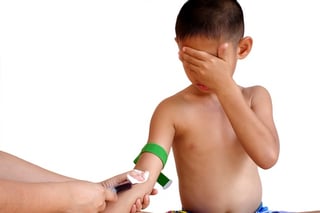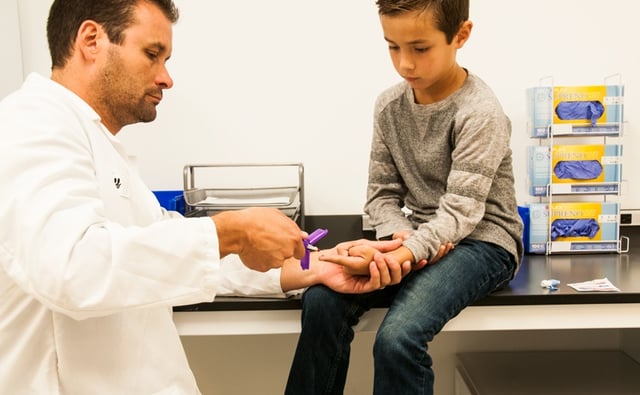Share this
how children experience venipuncture
by Neoteryx Microsampling on Feb 1, 2018 4:46:00 AM
 Imagine that you're four or five years old. Do you remember the perspective from which you viewed the world? Everything was bigger than you were, especially the things that frightened you, like fireworks, planes, clowns and elephants. You were little and easily frightened. A needle poke in the arm for a venipuncture blood draw was likely to be a traumatic experience.
Imagine that you're four or five years old. Do you remember the perspective from which you viewed the world? Everything was bigger than you were, especially the things that frightened you, like fireworks, planes, clowns and elephants. You were little and easily frightened. A needle poke in the arm for a venipuncture blood draw was likely to be a traumatic experience.
One of your worst fears was pain. Some pain you accepted as the price of having fun. Running, jumping, climbing trees and roller skating all involved pain when you fell down. Unless the injury was worse than usual (or your Mom was nearby), you'd just pick yourself up and go back to playing.
Other pains were much worse and more frightening, especially anything involving needles. Getting shots was terrible, but having blood drawn via a needle in your arm was worse.
Children feel pain just as adults do, but their brains are different in both anatomy and neurochemistry. A study done by scanning the brains of infants and adults with an MRI indicates that children may feel pain more intensely than adults. They certainly have a very different emotional reaction to pain than adults do.
Drawing blood from a young child can be difficult for everyone: the child, the parents and the laboratory technician. Children have a layer of subcutaneous fat that is protective from both injury and famine. But that fat buries their veins very effectively. Not until puberty do the veins start to be well defined. Before that, finding a vein requires at least a couple of minutes with a tourniquet tied tightly around the arm and some probing with a needle.
The whole experience is not only painful, but terrifying to the child, who has no idea why he or she is being attacked in this way. Sometimes the child has to be restrained in order to obtain the blood, which causes further trauma.
Microsampling is another way of collecting blood samples that doesn't involve drawing from a vein. Its pediatric applications in research and medicine are just beginning to be explored.

The blood is obtained from a single drop from a fingerstick, withdrawing far less blood from the child and far less painfully. The pain is so brief that most children don't even cry. They watch with fascination as the blood is drawn up into capillary tubes. Microsampling keeps kids calm, parents relaxed, and laboratory technicians sane.
Share this
- Microsampling (206)
- Research, Remote Research (119)
- Venipuncture Alternative (105)
- Clinical Trials, Clinical Research (83)
- Mitra® Device (73)
- Therapeutic Drug Monitoring, TDM (51)
- Dried Blood Spot, DBS (39)
- Biomonitoring, Health, Wellness (30)
- Infectious Disease, Vaccines, COVID-19 (24)
- Blood Microsampling, Serology (23)
- Omics, Multi-Omics (21)
- Decentralized Clinical Trial (DCT) (20)
- Specimen Collection (18)
- Toxicology, Doping, Drug/Alcohol Monitoring, PEth (17)
- Skin Microsampling, Microbiopsy (14)
- hemaPEN® Device (13)
- Preclinical Research, Animal Studies (12)
- Pharmaceuticals, Drug Development (9)
- Harpera Device (7)
- Industry News, Microsampling News (5)
- Antibodies, MAbs (3)
- Company Press Release, Product Press Release (3)
- Environmental Toxins, Exposures (1)
- July 2025 (1)
- May 2025 (1)
- April 2025 (2)
- December 2024 (2)
- November 2024 (1)
- October 2024 (3)
- September 2024 (1)
- June 2024 (1)
- May 2024 (1)
- April 2024 (4)
- March 2024 (1)
- February 2024 (2)
- January 2024 (4)
- December 2023 (3)
- November 2023 (3)
- October 2023 (3)
- September 2023 (3)
- July 2023 (3)
- June 2023 (2)
- April 2023 (2)
- March 2023 (2)
- February 2023 (2)
- January 2023 (3)
- December 2022 (2)
- November 2022 (3)
- October 2022 (4)
- September 2022 (3)
- August 2022 (5)
- July 2022 (2)
- June 2022 (2)
- May 2022 (4)
- April 2022 (3)
- March 2022 (3)
- February 2022 (4)
- January 2022 (5)
- December 2021 (3)
- November 2021 (5)
- October 2021 (3)
- September 2021 (3)
- August 2021 (4)
- July 2021 (4)
- June 2021 (4)
- May 2021 (4)
- April 2021 (3)
- March 2021 (5)
- February 2021 (4)
- January 2021 (4)
- December 2020 (3)
- November 2020 (5)
- October 2020 (4)
- September 2020 (3)
- August 2020 (3)
- July 2020 (6)
- June 2020 (4)
- May 2020 (4)
- April 2020 (3)
- March 2020 (6)
- February 2020 (3)
- January 2020 (4)
- December 2019 (5)
- November 2019 (4)
- October 2019 (2)
- September 2019 (4)
- August 2019 (4)
- July 2019 (3)
- June 2019 (7)
- May 2019 (6)
- April 2019 (5)
- March 2019 (6)
- February 2019 (5)
- January 2019 (8)
- December 2018 (3)
- November 2018 (4)
- October 2018 (7)
- September 2018 (6)
- August 2018 (5)
- July 2018 (8)
- June 2018 (6)
- May 2018 (5)
- April 2018 (6)
- March 2018 (4)
- February 2018 (6)
- January 2018 (4)
- December 2017 (2)
- November 2017 (3)
- October 2017 (2)
- September 2017 (4)
- August 2017 (2)
- July 2017 (4)
- June 2017 (5)
- May 2017 (6)
- April 2017 (6)
- March 2017 (5)
- February 2017 (4)
- January 2017 (1)
- July 2016 (3)
- May 2016 (1)
- April 2016 (2)



No Comments Yet
Let us know what you think